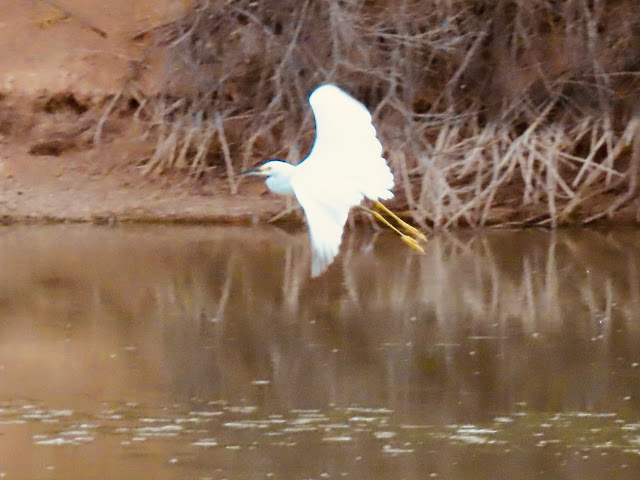Three reports:
July 31, 2020 Goldfield Recreation Area along the Lower Salt River
August 8, 2020 Hassayampa River Preserve, Wickenburg, AZ
August 13, 2020 Riparian Preserve at Gilbert Water Ranch
1) GOLDFIELD
Having attempted unsuccessfully to post this experience earlier, I'm doing a short version here.
Using the concrete trail down to the stony beach area, Lisa turned left to photograph a bird high in a bare-limbed tree.
She motioned me over and, guess what? It turned out to be our target bird, PEREGRINE FALCON. This, the fastest bird on earth, was right here along the Lower Salt River!!
Continuing to bird the eventual horse trail up on the slight bluff above the Salt River, we spotted numerous BROWN-CRESTED FLYCATCHER, a few immature BLACK-TAILED GNATCATCHER and BLACK-THROATED SPARROW.
When we reached the bluff where I usually looked for the Peregrine, one was perched at the spot where Lisa had spotted it previously. It was quite distant, but pictures were possible.
Peregrine Falcon (Pacific subspecies) high on the sandstone cliff east of the parking area at Goldfield.
The helmet-type head is indicative of the Pacific subspecies in contrast to the distinctive "sideburn" of the Tundra subspecies that we often see. On the Tundra type, no helmet exists. What I call a neat "sideburn" is called a "mustache" in Sibley, but the black perpendicular feathers from the eye down to its neck is set off by its white face or cheek.
Some kayakers paddled past inquiring as to what was so interesting up on the rock face. They told us they had just seen a Peregrine from where they paddled in. Walking away, then, from the Peregrine high above us, we continued eastward until I glanced at the cliff again and spotted what was probably the kayakers' "Peregrine" perched much closer, lower and farther east than the first higher one on the western edge of the cliff.
It's not everyday, a target bird shows up in triplicate! Obviously, we were delighted.
View this checklist online at https://ebird.org/checklist/S71979380
Again with Lisa Genuit, we met her birder friend, Debra at the Roadside Rest in Wickenburg where we warmed up with some good bird sightings before heading up Route 60 another five miles (approx) to the Preserve. I was able to get the WILLOW FLYCATCHER at its stake-out area, but no photo. Lisa was interested in finding out if the Streak-backed Oriole had hatched eggs in the nest, but with a reasonable stop at that stake-out, there was no action.
TROPICAL KINGBIRD is a favorite of mine, from its twittering call to its full bright yellow underneath feathers from UTC to top of chest. Lucked out with several good sightings and photos:
Overhead, we had LESSER NIGHTHAWK circling during our entire walk over several trails.
Lisa and Debra ahead of me on the trail
We saw more than birds at Hassayampa, one of the best real wilderness areas around.
It was too busy foraging to bother us, thank goodness!
A young VERMILLION FLYCATCHER caught my eye. Not yet quite an adult, its under feathers were bright red.
Its dense coloration was way too much for it to be a female VERMILLION that looks like this one found flitting around at Palm Lake.
Also at the lake, we watched a young AMERICAN COOT, looking nothing like the adult, foraging from a log.
After we finished the River Ramble Trail, Lisa and Debra wanted to return to some of the areas we'd already covered. I begged off; it was getting hot and I was hungry! After cooling off in the car and munching on a few things, I ambled out again for what became the most exciting moment of the day for me.
Hanging around the picnic area, I had watched three older couple walk the trail toward Palm Lake only to be turned around by the Willow Flycatcher staked-off area. They needed to go around the longer route. As they started up that way, a woman screamed and pushed her husband (assumed) forward. When I walked up to see why she was in such a panic (she hadn't stayed with him but returned to the others), they pointed out a nice fat Diamondback Rattlesnake! Whoa! She explained that her husband couldn't hear but why she didn't stay forward with him, I don't know. She was really panicked.
I suggested they continue on their way around the lake to allow the rattler to cross the trail which it appeared to want to do. Yay! They went on their way; I took photos--many many photos-- of the rattler. Here are a few:
Diamondback Rattlesnake - 4 above photos
By the time Lisa and Debra returned to the parking area, I had eaten most of my food, was drinking lots of water and was feeling really good! You never know what's lying in the desert.
View this checklist online at https://ebird.org/checklist/S72210681
3). GILBERT WATER RANCH:
Feeling a bit crazy to start out to bird on such a hot day, I found myself up early and preparing to go. The temperature last night when I went to bed at 9:00, was 100° at home. At 3:30 a.m., it was 90°F. Good grief. That's when I usually return home from birding! But here I was, on my way and arriving a half hour before sunrise!
View this checklist online at https://ebird.org/checklist/S72368279























No comments:
Post a Comment